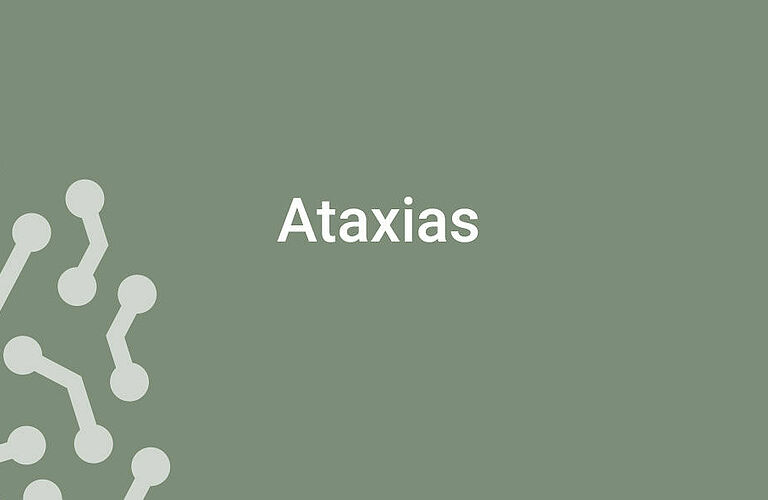When movements become disordered
The term "ataxia" is derived from the Greek word "a-taxia" meaning "a lack of order". Ataxia is the name for a number of rare disorders of the brain and spinal cord in which the interaction between various muscle groups of the body is disturbed. As a result, balance and coordination of movements are impaired. Walking is affected, as is sitting or standing, speaking, hand movements, and the control of eye movements. The person's gait becomes unsteady and wide-based, handwriting may become illegible, gripping and holding objects difficult. Others affected cannot sit or stand upright without support. Further, speech may also be affected, becoming indistinct and slurred.
Ataxias differ from Parkinson's disease (PD) and amyotrophic lateral sclerosis (ALS) in that ataxias are mostly disturbances in balance and coordination, whereas Parkinson's disease causes depleted and slowed movements as well as tremors and muscle stiffness, and ALS causes paralysis and spasticity.
Ataxias can occur at any age – even in children. According to estimates, around 16,000 people are affected in Germany, men and women alike.
Impaired communication between cerebellum and spinal cord
When it comes to fine-tuning body movements, the cerebellum and the spinal cord are crucial players, as well as the connections between them and with other parts of the brain. If communication is disturbed, the coordination and execution of these movements suffers.
Acquired or genetic
Acquired ataxias usually result from damage to the cerebellum, which can have a variety of causes. They may stem from circulatory disorders, such as a stroke, from inflammatory diseases or autoimmune diseases, but also from infections or tumors, as well as from malnutrition, injuries, poisoning or alcohol abuse.
In addition, ataxias may be genetic. In hereditary ataxias, there are at least 200 different gene mutations that cause the disease. The cause of congenital, hereditary ataxias is a progressive loss of certain neurons in the cerebellum, for which different genetic alterations are responsible, depending on the subtype. Hereditary ataxias may be dominantly inherited ataxias, passed from one generation to the next. Patients often know that the disease runs in the family. Among dominantly inherited ataxias, spinocerebellar ataxia type 3 (SCA3) is the most common. It is also called the Machado-Joseph disease and usually begins between the ages of 30 and 40 years.
If the parents are not affected, but their child or several siblings have the disease, it is called a recessively inherited ataxia: This means that the parents are both only carriers of the disease-causing hereditary trait, but the disease does not break out in them. For the child to develop the disease, both parents must forward the gene mutations. Among all recessive ataxias, Friedreich's ataxia is the most common. The disease begins in childhood or puberty: The parents of the affected persons are healthy, while the affected persons, who have developed according to their age so far, begin to experience disorders in their balance and coordination. This leads to difficulties in walking and falls. As Friedreich's ataxia progresses, the children may then depend on a wheelchair.
Currently, ataxias cannot be treated with medication yet. However, regular physical therapy with active exercises to promote coordination can permanently alleviate symptoms.
DZNE: Large clinical trials to better understand ataxias
Researchers at the DZNE at several sites are dedicated to studying ataxia in various large clinical trials. The focus is on genetic ataxias. For example, they examine the course of spinocerebellar ataxias and search for measurable biological characteristics (biomarkers such as in the blood or cerebrospinal fluid) for early detection and monitoring.
In addition, scientists at the DZNE are also devoting their time to new avenues for therapy. For example, they are working on new gene therapies that are individually tailored to the affected person in order to slow down or even stop the progression of the disease in genetically caused forms of ataxia. One promising approach is "antisense therapy", where certain medications are intended to act directly on the gene mutation and block the conversion of the pathogenic hereditary information contained in the genes.
Machado-Joseph disease
Machado-Joseph disease first came to the attention of the medical community in the United States in the 1970s– in descendants of immigrants from the Azores. However, the origin of this hereditary ataxia is probably not in the Azores. Genetic analyses suggest that the origins of the disease were in East Asia thousands of years ago. Portuguese sailors then brought the disease in their genes to the Azores and other parts of the world.
Status as of 22.11.2021

